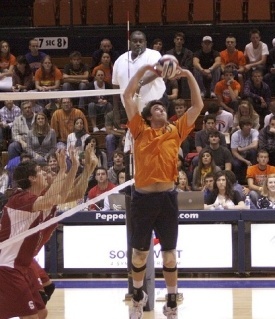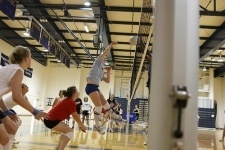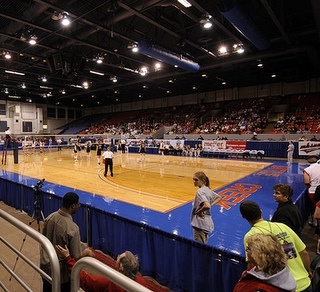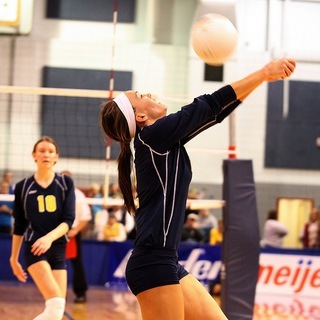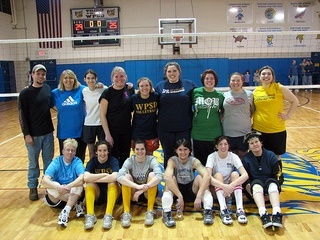I shouldn’t do this, but these volleyball plays are the ones that we use for our5 1 offense. I am going to pass them on to you now…
Since the setter is running the offense, usually he will signal the plays to the front and back row hitters. He is frequently looking at the defense to find a mismatch.
If he finds that one of our strongest hitters will be hitting where one of their weakest blockers is going to be, he will usually set the ball there to increase our chances of a point. However…
Important! EVERYTHING starts with a good pass. If we give the setter a bad pass, he is very limited in where he puts the ball for the hitters. A good play always starts with a good pass.Our front row plays work off of a numbering system. Depending on the number that the setter calls, depends on who is hitting it and where. The number will show the position of the set and the height of the set.
The plays I am going to show assume that are have an offense with three front row hitters. If you don’t, then the plays for the opposite are not applicable.
Outside Hitter Plays
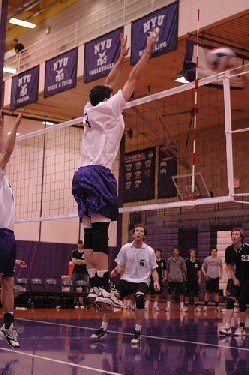 #4 – The setter calls this volleyball play by showing the outside hitter four fingers. This is a standard set to the outside. It is high and to the outside. The ball will be just inside the antenna so that the hitter can either hit the ball down the line or cross court. The hitter will take their typical four step approach as discussed in the techniques section.
#4 – The setter calls this volleyball play by showing the outside hitter four fingers. This is a standard set to the outside. It is high and to the outside. The ball will be just inside the antenna so that the hitter can either hit the ball down the line or cross court. The hitter will take their typical four step approach as discussed in the techniques section.
#3 – We call this a tandem. The setter calls it by showing three fingers and shaking his hand. This set will be to the same spot on the floor as the 4, but it will be about half as high. Meant to be a little faster so that the middle blocker cannot get there. The hitter must start his approach sooner.
Shoot – This is a fun play. The setter will call this play by making a gun with his fingers (thumb and index finger). The shoot set is where the setter is going to fling the ball to the outside just above the height of the net. The hitter is going to start jumping when the setter gets the ball in his hands so that he will be in the air when the ball gets there. A very fast play but requires a good pass.
#2 – This is typically called for the middle blocker, but you will see how it can be used for the outside further down this page. A two is about medium height and in the middle.
Middle Blocker Plays
#1 – This volleyball play is my favorite. The middle blocker will do their approach and be right next to the setter at the end of their approach. The setter will set it right above them and just high enough to be slightly higher than the net. The middle blocker will be jumping as the setter is setting the ball. The play is meant to catch the defense off guard and it usually results in the middle pounding the ball.
#2 – As described above, it is in the middle and a medium high set. The middle blocker will usually do this to see where the defensive block is going to be coming from. The only downside about this play is that with a higher set, the defense has more time to react and get blockers in place. With this set, a triple block can be common, which is not a good thing.
#3 or #31 – The setter calls this play by using his three end fingers. This play is very similar to #1. It is going to be a quick attack. The major difference is that it is a mini shoot. Instead of the middle making their approach right next to the setter, they will put a couple of body widths between them and the setter. The purpose of doing this is to keep the defense confused on where the block needs to be.
Back #1 – The setter will call this play using his pinky finger. This lets the hitter know that a back #1 has been called. It is the same as #1, but the set is going to be just behind the head of the setter. The purpose is to keep the defense guessing.
Back #2 – Again, the setter will call this volleyball play with his end two fingers to let the hitter know the ball is going to be behind him.
We do not run a lot of back ones or twos, but it is nice to have the option and keep the defense guessing.
Opposite Hitter Plays
There isn’t a whole lot of plays for the opposite since the setter has to set behind him to get the ball there.
#5 – The setter will show all 5 fingers. This is just like the four for the outside hitter, but it means that the ball is going to go behind the setter. This is a back set from the setter high and outside. Again, this can be a great option if the opposite is hitting against a weak blocker on the other team.
Back #2 – Just as described above. The setter could call a back two for the opposite if he had the middle blocker hitting a #1 and wanted to use the middle blocker as a decoy to pull the blockers.
Back Row Attacks
Our back row attack plays are very simple. The setter will rub his chest showing the hitter where the set is going to be. How can a volleyball play be more simple?
The setter will face the back row, and then rub where the set is going to be (usually to the strongest hitter on the back row). He can rub his sternum for the middle, or left and right shoulders for the other positions.
Remember that the hitter must jump behind the attack line or it is a violation and the other team gets the point.
During the middle of a rally, a back row hitter will call “pipe” to let them know that they are ready for the ball.
Combination Attacks
The combination attacks can be deadly volleyball plays when used together. Here are a couple of gems that we love to run. By the way, this is the really good stuff!
Double Quick – This volleyball play is where the setter will call a shoot for the outside hitter and a #1 for the middle blocker. Since both players are making their approach and jumping at the same time, the defense has to choose which one they are going to block. The setter reads the blockers and delivers the ball where appropriate. Again, you must a have a good pass to do this.
If the pass is bad, the setter either uses the opposite as their safety valve, or uses a back row attack.
X Play – The X play is also a lot of fun. This volleyball play is where the setter will call a #1 for the middle blocker and a #2 for outside hitter. The basic idea is that the middle blocker is doing a quick attack with the outside hitter following right behind them for a #2. The setter will read the defense and put the ball where it needs to be.
Since the blockers have to block the middle blocker, they are usually landing from the block when the outside hitter is hitting the #2. If the blockers don’t go up and block the middle hitter, then the setter can deliver the ball there. This is a great play to get the blockers guessing.
Well, this is our system to call volleyball plays and some of the combinations that we use. Have fun with these and experiment with them. You will find some good results in your team’s ability.

